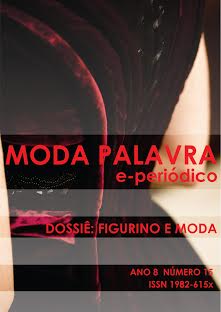A percepção do design como posicionamento no segmento de moda
DOI:
https://doi.org/10.5965/1982615x08152015222Palabras clave:
marketing estratégico, design estratégico, modaResumen
A sociedade de consumo tem evoluído através de transformações no mercado da moda e com isso, inovação e diferenciação tornam-se fatores determinantes às organizações. O design pode ser um grande aliado das empresas nesse contexto. O presente artigo busca avaliar a percepção de especialistas sobre o posicionamento estratégico por meio do design e para isso foi desenvolvida uma pesquisa de abordagem qualitativa junto a profissionais atuantes nas áreas de design, marketing e moda. O resultado obtido demonstrou o caráter estratégico do design integrado ao marketing em níveis gerenciais, como meio de obtenção de vantagens competitivas e auxiliar importante na elaboração de estratégias de segmentação e posicionamento. O design pode promover diversos benefícios às empresas e, sobretudo, favorece a compreensão de necessidades, desejos e demandas futuras do mercado de moda, o que pode ser essencial no relacionamento entre empresas e clientes, desenvolvido pelo marketing.
Descargas
Citas
AAKER, David A. Administração estratégica do mercado. 9. ed. Porto Alegre, RS: Bookman, 2012.
BRANDINI, V. (2007). Bela de morrer, chicde doer, do corpo fabricado pela moda: o corpo como comunicação, cultura e consumo na moderna urbe. Contemporânea -Revista De Comunicação e Cultura, 5(1), 1-28.
BROEGA, Ana Cristina; MAZZOTTI, Karla. Marcas de moda: identidade, imagem, comunicação e consumo social. 5º Congresso Latino-americano de Moda, Set./2012. Cartagena da LasIndias, Colombia.
COBRA, Marcos. Marketing & moda. São Paulo, SP: SENAC São Paulo, 2007.
FRANZATO, Carlo. O processo de inovação dirigida pelo design: um modelo teórico. REDIGE,vol. 2, n.1, 2011.
INTERNATIONAL COUNCIL SOCIETIES OF INDUSTRIAL DESIGN. Disponível em:<http://www.icsid.org>. Acesso em: 23 de agosto de 2013.
KOTLER, Philip; ARMSTRONG, Gary. Princípios de marketing.9.ed. São Paulo, SP: Prentice-Hall, 2003.
KOTLER, Philip. Administração de marketing. 10.ed. São Paulo, SP: Prentice-Hall, 2002.
LIPOVETSKY, Gilles. A felicidade paradoxal: ensaio sobre a sociedade do hiperconsumo. Lisboa: Edições 70, 2010.
MALHOTRA, N. K. Pesquisa de Marketing: uma orientação aplicada. 4. ed. Porto Alegre: Bookman, 2006.
MCCRACKEN, G. (2007). Cultura e consumo: uma explicação teórica da estrutura e do movimento do significado cultural dos bens de consumo. Revista de Administração de Empresas, 7(1), 99-115.
MONTEIRO, Plínio Rafael Reis; VEIGA, Ricardo Teixeira. Personalidade e segmentação do mercado de moda: contrastes e perfil de jovens inovadores segundo o gênero. PRETEXTO, vol.10, n.1, p.69-87, jan./mar. 2009.
MOZOTA, Brigitte Borja de; KLÖPSCH, Cássia; COSTA, Filipe Campelo Xavier da Gestão do design: usando o design para construir valor de marca e inovaçãocorporativa. Porto legre: Bookman, 2011.
NETO, Alfredo José Machado; GIRALDI, Janaina de Moura Engracia. Análise do posicionamento de indústrias Calçadistas na região de franca.RAE, vol.48, nº1, p.36-47, jan-mar/2008.
PRODANOV, Cleber Cristiano; FREITAS, Ernani Cesar de. Metodologia do trabalho científico:métodos e técnicas da pesquisa e do trabalho acadêmico. Novo Hamburgo, RS: Feevale, 2009.
RECH, Sandra Regina. O gestor de design de moda: agente diferenciador no mercado globalizado. Actas de Diseño. Ano 2, vol. 3, jul/2007, Buenos Aires, Argentina.
RIES, Al; TROUT, Jack. Posicionamento: a batalha por sua mente. São Paulo: Pioneira, 2001.
VEIGA-NETO, Alípio Ramos. Um estudo comparativo de formas de segmentação demercado: uma comparação entre VALS-2 e segmentação por variáveis demográficas comestudantes universitários. Revista de Administração Contemporânea, vol. 11, nº1, Curitiba, jan-mar/2007.
ZURLO, F. Il Design del sistema prodotto. In: P. BERTOLA; E. MANZINI(eds.), Design multiverso. Milano, EdizioniPolidesign, 2004.
Descargas
Publicado
Cómo citar
Número
Sección
Licencia
Derechos de autor 2014 Cristine Einsfeldt, Vera Denise Muller

Esta obra está bajo una licencia internacional Creative Commons Atribución-NoComercial 4.0.
Al enviar un artículo para su publicación en ModaPalavra e-periodico, el (los) autor (es) aceptan los siguientes términos:
- Los autores mantienen los derechos de autor y otorgan a la revista el derecho a la primera publicación, con el trabajo licenciado simultáneamente bajo Creative Commons Attribution-NonCommercial 4.0 International, que permite compartir el trabajo con reconocimiento de autoría y publicación inicial en esta revista, sin pago;
- Los autores pueden utilizar los mismos resultados en otras publicaciones después de la primera publicación, siempre que indiquen ModaPalavra e-periodical como medio de publicación original;
- Los autores pueden asumir contratos adicionales por separado solo después de la publicación inicial en ModaPalavra e-periodical, siempre que indiquen ModaPalavra e-periodic como el medio de publicación original;
- Se permite y anima a los autores a publicar y distribuir su trabajo en línea (por ejemplo, en repositorios institucionales o en su página personal), solo después del proceso editorial y la primera publicación, siempre que indiquen el ModaPalavra periódico electrónico como medio de publicación original;
- Para indicar ModaPalavra e-periodic como medio de publicación original, el autor debe seguir el texto modelo: "Este artículo fue publicado originalmente por ModaPalavra e-periodic, bajo la licencia CC BY NC, en su volumen [insertar volumen], número [ insertar número] en el año de [insertar año], y se puede acceder en: http://www.revistas.udesc.br/index.php/modapalavra/ ";
- Las opiniones expresadas en los artículos son responsabilidad exclusiva de los autores y no reflejan necesariamente la opinión de la revista. La publicación de artículos, fotografías y dibujos fue previamente autorizada por los responsables o sus representantes para su publicación en ModaPalavra e-periodic.









